#hong kongese
Explore tagged Tumblr posts
Text

Monument Valley, Arizona, Tseng Kwong Chi, 1987
#photography#vintage photography#vintage#tseng kwong chi#arizona#landscape#monument valley#1980s#1987#gelatin silver print#american#chinese#asian artists#sepia#queer artists#lgbtqia artists#hong kongese#100 notes
341 notes
·
View notes
Text
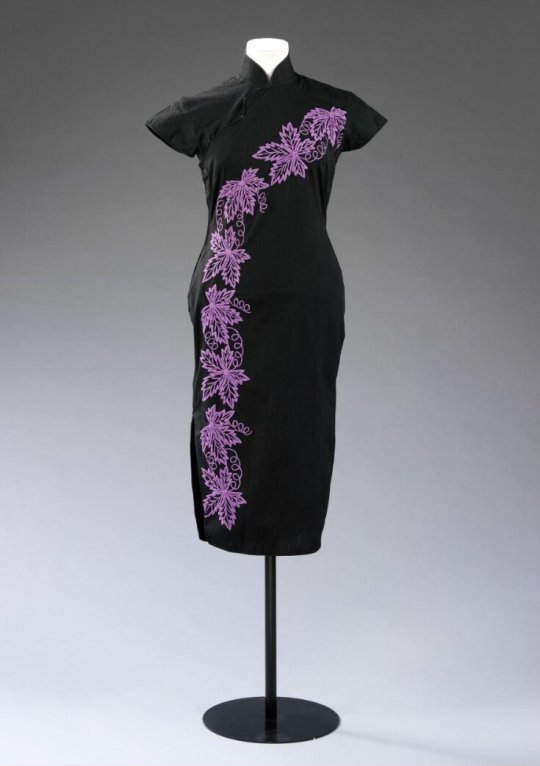
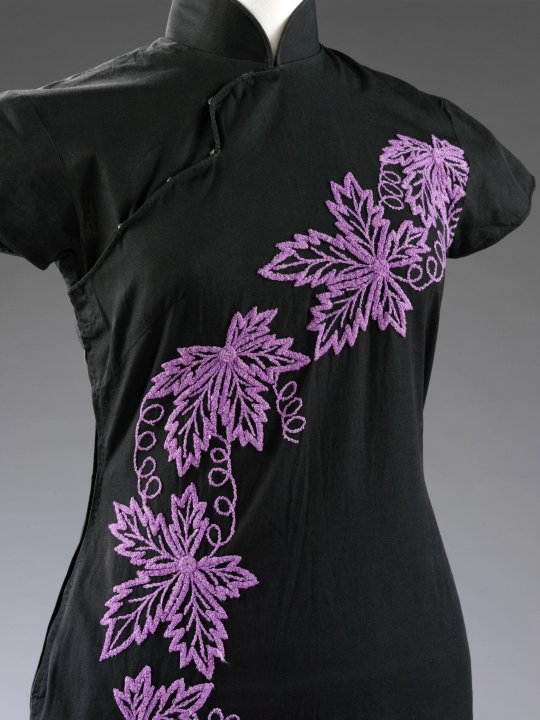
Qipao | c.1950s | Hong Kongese
33 notes
·
View notes
Text
Day 270
Today’s Asian character is Lanzhu Zhong from Love Life!
She is a Hong Kongese.



7 notes
·
View notes
Text
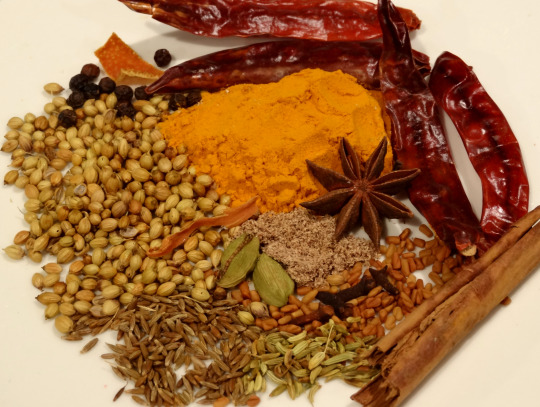
[ID: A plate of whole and ground spices including red chilis, Ceylon cinnamon, coriander seeds, and star anise. End ID]
新加坡咖哩粉 / Xinjiapo gali fen / Curry powder Singapura (Singapore curry powder)
Singapore curry powder, or gali fen ("gali" from the English "curry"), is a spice blend that was inspired by British Madras curry powder, but grew to incorporate Chinese spices and aromatics. It is representative of the culinary culture of Singapore, which incorporates influence from Chinese, Indian, Thai, Malay, and Indonesian cuisines.
This blend is used in “Singapore” curry fried noodles (actually a Hong Kongese dish) and in other Chinese curry dishes including chicken curry (新加坡式咖喱鸡), beef brisket curry (咖喱牛腩饭), curry soup noodles, and vegetable curries. It is also a popular choice for marinating meat and seafood.
Curry powder Singapura starts from a base of dried red chilis, and is rounded out with earthy spices including turmeric, coriander, cumin, and fenugreek. Warming spices such as nutmeg, mace, cinnamon, and cloves are often also included. Chinese influence sometimes appears in the form of chenpi (dried mandarin orange peel), Sichuan peppercorn, dried radish, liquorice root, star anise, and dried ginger.
Recipe under the cut!
Patreon | Tip jar
Makes about 1/3 cup.
Ingredients:
2 Tbsp (17.4g) ground turmeric / 薑黃
10 dry red chilis (11g; adjust to taste)
2 Tbsp (8g) coriander seeds / 芫茜
1 tsp (3.6g) fenugreek seeds (optional)
1 tsp (2.5g) cumin seeds / 小茴香種子
1 tsp (2g) fennel seeds / 谷茴
1 tsp (2g) ground ginger (optional)
1/2 tsp (1.6g) black peppercorns
1 inch (1.5g) Ceylon cinnamon / 桂皮
1 pod (1.4g) star anise / 八角
1g liquorice root / gan cao / 甘草 (optional)
1g chenpi / 陳皮(optional)
1g cao guo / tsao ko / 草果 / Chinese black cardamom, freshly grated (optional)
4 (1g) green cardamom pods
1/2 tsp freshly grated nutmeg / 玉果 (1/4 tsp preground; .5g)
1/4 tsp (7; .4g) cloves
2 blades mace (.2g; optional)
Liquorice root, chenpi, and cao guo may be found at an east Asian or Chinese grocery store, but may need to be purchased online. Many homemade versions of this spice blend do not include these spices.
Hong Kong curries tend to be relatively mild and sweet, including a lot of turmeric and cinnamon relative to the amount of chili and pungent spices. You should adjust the heat, sweetness, and pungency of the blend to your taste.
Instructions:
1. For a less spicy curry powder, you may choose to break open the chilis and remove all or some of their seeds.
2. Roughly crush star anise, cinnamon, nutmeg, and cardamom pods in a mortar and pestle or with the flat of a knife. In a small, dry skillet, toast whole spices (coriander, fenugreek, cumin, black pepper, cinnamon, fennel, star anise, nutmeg, cardamom, Sichuan peppercorn, cloves, and mace) one at a time until each is fragrant. Set aside and allow to cool.
Spices are toasted one at a time so that smaller spices don't burn before larger ones are fully fragrant. Sometimes, I'll toast larger spices (such as cloves and cardamom pods) together, and then toast smaller seeds (such as cumin) together, to speed up the process.
3. Remove pan from heat. Toast ground spices (turmeric, and anything else you used a ground version of) for 30 seconds, stirring constantly, and remove from the skillet.
4. Grind liquorice root in a spice mill or coffee grinder until as fine as possible, then pass it through a sieve to remove larger pieces. Return those pieces to the mill and grind again. This is done separately because liquorice root can be tough to grind!
5. Grind all spices in a spice mill until fine. Pass through a sieve. Store in an airtight container in a cool, dry place.
72 notes
·
View notes
Text

#xodiac sing#mak chun sing#xodiac#hong kongese#hot guy#male idols#black tank top#asian guys#born 2002
20 notes
·
View notes
Text

#HAUGHEY Siobhan Bernadette#siobhan haughey#hong kongese#swimmer#sporty girls#paris 2024#siobhan#olympian
5 notes
·
View notes
Text

When The Fox Scholar is Charmed by The Peddler
My (late) submission for Week 1 of Tea’s SuoSaku MonsterFucking Month, inspired by Episode 2: Goose Mountain from the Yao-Chinese Folktales (2023).
Bonus Art + Sneak Peak for Week 2

Bro just dubcon-ed the poor guy for his geese and ran off, leaving a very angry and confused (+ a lil turned on) vendor.
Also, I’ve had the Fox Yaoguai-Scholar! Suo thing stuck in my brain for weeks and I just decided to use the idea for Tea’s MFM na lang because why not…and it’s hot. On that note, I originally had the idea to assign the boar demon to Sakura (which if you aren’t familiar with the story; the boar demon is the lover of the fox demon’s concubine aka rabbit demon), but then I remember the chemistry between the peddler and the fox scholar so I went with that instead.
Lastly, here’s a lil preview of my piece for Week 2: Ghosts/“He Came Back Wrong”

#teasskmfm#wind breaker#wind breaker nii satoru#sakura haruka#haruka sakura#suo hayato#hayato suo#suosaku#suo x sakura#if you can’t tell i'm bringing the chinese/hong kongese suo agenda to the table with these art prompts#the way i let my wbk blog take an impromptu week long hiatus is killing me inside#anyways thanks tea for feeding us so good this month and hosting (essentially) a collab ssk buffet#also ignore my handwriting pls i beg#and suo with long hair facing away is giving too much hua cheng for me 😭#my social anxiety kept me from joining the server but all of y’all are really cool esp the writers and artists that already posted
111 notes
·
View notes
Text






Gillian Chung's costume fitting pictures for Love Game In Eastern Fantasy
#gillian chung#gillian chung ka lai#chung yan tung#weibo repost#hong kongese actress#uploads#chinesemedia#hanfu#cdrama#love game in eastern fantasy
10 notes
·
View notes
Text

The Butterfly Murders (1979)
27 notes
·
View notes
Text
The Side Look of a Barcelonese #1 986 : Night Street Jordan © Shojiroh Yamagata aka Zirosou :
The Side Look of a Barcelonese #1 986 : Night Street Jordan © Shojiroh Yamagata aka Zirosou :
#shojiroh yamagata#zirosou#the side look of a barcelonese#choice of the day of YWAMag#choice of the day of the mag#art#night shots#architecture#moody images#emotions#masters on tumblr#perfections#gifts#decay#street photography#hong kongese photographers#japanese photographers#masterpieces#yes we are magazine#composition#contemporary art#visual poetry#visual art#artists on tumblr#photographers on tumblr#original photography
4 notes
·
View notes
Text

"As evening hurries by", Hong Kong, 1955 - by Fan Ho (1931 - 2016), Chinese/Hong Kongese
501 notes
·
View notes
Text

apex is doing an in-character AMA as alter on reddit but it seems like a lot of people are unaware that alter is hong kongese and speaking cantonese so when they're translating her responses they're using a mandarin translator. which has now lead to this moment where it seems like alter is saying she likes to jack it LMFAO
121 notes
·
View notes
Note
Chrysalis aakumatized Marinette and Socqueline into Li Mochou and Yuenu due to someone insulted Louis Cha's works?

This is the draft.
A communist guy talks bad about Louis Cha (1924-2018) (a real-world Chinese(Hong-Kongese) writer). The latter's ghost appears behind the former.
Marinette and Socqueline are hearing the baddie's words. Chrysalis akumatizes the two girls into Li Mochou and Yuenu. They are going to crush the guy.
#miraculous ladybug#satire#satirical#marinette dupain cheng#socqueline wang#akumatized marinette#akumatized socqueline#chrysalis#lila rossi/cerise#my art#louis cha#parody#ask#anonymous#sketch
12 notes
·
View notes
Text
As evening hurries by Hong Kong
1955
Fan Ho
1931 - 2016
Chinese/Hong Kongese

#Fan Ho#artists photographie#As evening hurries by Hong Kong#original photographer#art#original art#black and white photography#photographer#art style#fotos art#xpuigc#xpuigc bloc
13 notes
·
View notes
Text
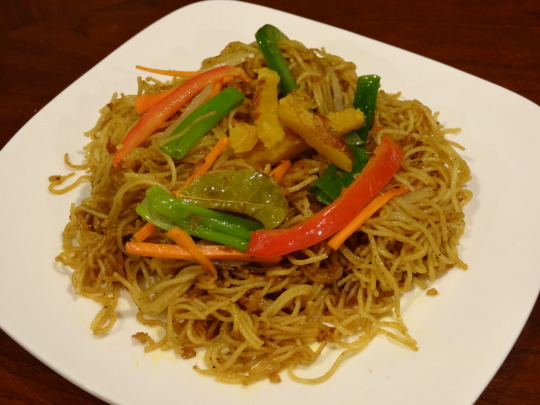
星洲炒米粉 / Xing zhou chao mei fun (Singapore noodles)
This dish fries steamed noodles and assorted vegetables in a mildly spicy curry paste, made from a bespoke curry powder and a blend of fresh aromatics. The result is a crispy, chewy, complex, warming stir-fry with notes of turmeric, liquorice root, and cinnamon.
Though this dish is referred to as "Singapore noodles," vermicelli dishes common in Singapore do not include curry powder! These "Singapore" noodles in fact originated in Hong Kong 茶餐廳 (cha chaan teng; Western-influenced cafés), and gained popularity between the 1940s and 60s. They combine British influence (in the form of curry powder) with the rice noodles common in Chinese, Malay, and Indian cooking; the reference to Singapore is perhaps a nod to the cosmopolitan, "exotic" atmosphere of these cafés.
This is a vegan version of a dish that often also includes shrimp, char siu, or chicken. Instructions for a vegan version of the typical sliced fried egg topping are included.
Recipe under the cut!
Patreon | Tip jar
Serves 3-4.
Ingredients:
For the dish:
200g vermicelli rice noodles (bee hoon / mi fen; 米粉)
4 green onions, greens and whites separated
1/2 medium yellow onion, thinly sliced
1 medium (50g) julienned red mild chili (such as aji dulce), or 1/4 medium red bell pepper
1 medium (50g) julienned green mild chili, or 1/4 medium green bell pepper
1 bunch yellow chives
Small handful bean sprouts
3-inch piece (40g) carrot, julienned
1 tsp table salt, or to taste
Large pinch MSG (optional)
Rice vermicelli (also known as bee hoon / bihun, mee hoon / mihun, or mi fen) are long, fine rice noodles. They should not be confused with semolina vermicelli. They may be purchased at an east or southeast Asian grocery store; Chinese, Vietnamese, or Thai rice vermicelli will all work. I used Hai Ca Vang rice vermicelli, which I like in this dish for how well they stand up to stir-frying, and the chewy bite they give to the final dish.
Yellow chives are simply chives that have less color because they are grown out of the sun. They may be found in a Chinese grocery store; if you can't get your hands on any, omit them or substitute more bean sprouts.
For the curry paste:
4 tsp curry powder Singapura, or to taste
3 cloves garlic
4 Thai shallots, or 1 Western shallot
1-inch chunk (10g) ginger
1/4 medium yellow onion
White of 1 stalk lemongrass (optional)
1 bay leaf (optional)
Some versions of Singapore noodles are flavored entirely with curry powder, or (if a spicier curry powder is being used) with a mix of curry powder and turmeric; home cooks tend to include less curry powder or paste than restaurants do. You could decrease the amount of curry powder down to about a teaspoon for a home cook version of this dish. If you aren't making your own, Singapore curry powder (咖哩粉) can be purchased online from specialty spice retailers, or from a Hong Kongese brand such as Koon Yick Wah Kee; you could also substitute another mild, sweet curry powder, such as Japanese curry powder (S&B is a popular brand).
You could skip prepping the aromatics as well by purchasing a jar of ready-made Chinese curry paste (咖哩醬) from a brand such as Koon Yick Wah Kee (whose blend consists of curry powder hydrated with white vinegar and soybean oil); Malaysian curry paste would be a good substitute. Some recipes make a quick homemade curry paste by combining curry powder with salt (1 tsp), sugar (1 tsp), oyster sauce (1 Tbsp), water (2 Tbsp), and sometimes chili sauce, and add this sauce to the noodles as they are fried. I prefer versions of the dish that add fresh aromatics, though—I think they round out the curry powder by providing a flavorful base for it. You can experiment until you get the flavor and texture you prefer.
For the egg:
1/4 cup (60mL) coconut milk, or water
1/2 tsp ground turmeric
1/4 - 1/3 tsp kala namak (black salt)
1/4 tsp ground white pepper (optional)
1/2 tsp Liaojiu (Chinese cooking wine)
Liaojiu will likely be labelled "Shaoxing wine" in English. For an alcohol-free version, use ume plum vinegar or apple cider vinegar. The wine is used to flavor and cut the 'egginess' of the eggs.
This recipe usually calls for eggs, liaojiu, and salt. The turmeric and white pepper add flavor and color; the kala namak provides an eggy taste.
Instructions:
1. Prepare the aromatics. Peel and chop the garlic; mince the onion and shallots; scrub and mince the ginger (there's no need to peel it). Divide the whites of the green onions from the greens, and mince the whites.
Pull away any tough outer leaves of lemongrass. Separate the yellow / white section from the green, and cut off the root end. Reserve the green to flavor soup stocks. Thinly slice the white of the lemongrass widthwise, then pass the knife through for another few minutes to mince very thoroughly.
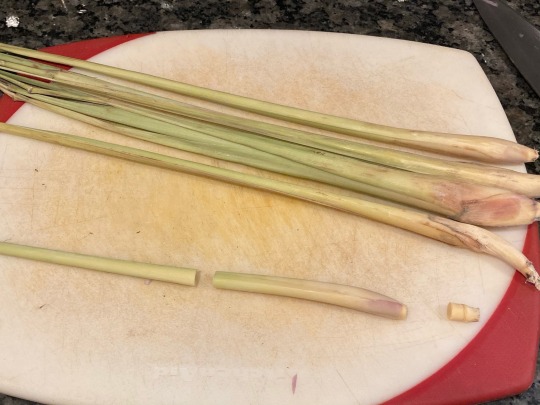
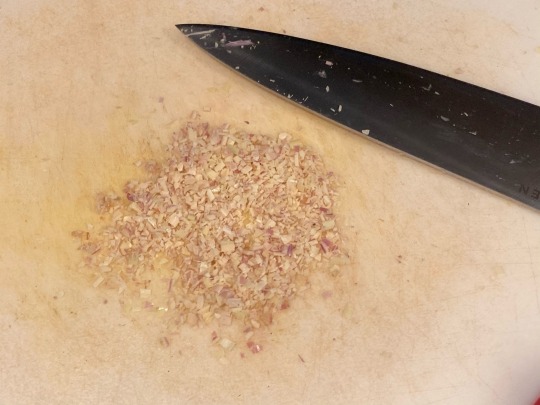
For a "saucier" noodle dish, pulverize the aromatics in a mortar and pestle or a blender rather than mincing them.
2. Prepare the vegetables. Cut peppers into a thin julienne; julienne the carrots; thinly slice the onion. Cut the greens of green onions, bean sprouts, and chives into 1 1/2 or 2” pieces.
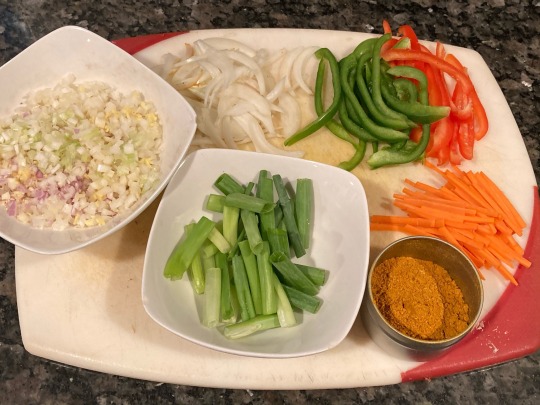
3. Cook the noodles. Soak noodles in just-boiled water for about 90 seconds, or until they break when pinched firmly. Depending on the thickness of your noodles, they may need as much as 2-3 minutes.
Drain the noodles, but don’t rinse them. Spread them out on a baking sheet and cover to allow to steam for 10 minutes. With oiled hands, gently pull apart and untangle the noodles. Cut them in a few places with kitchen scissors to make stir-frying easier.
4. Cook the egg garnish. Whisk all ingredients for the egg together in a small bowl. Heat a wok over medium heat for several minutes, then add in a couple teaspoons of oil and swirl to coat the surface of the wok. Pour ‘egg’ into the bottom of the wok, then lower heat to low and allow to cook until darkened and solidified on top. Flip and cook the other side on medium-high until browned in places. Remove from wok and thinly slice.
5. Cook the vegetables. Heat wok on high for several minutes. Add in a couple teaspoons of oil and swirl to coat. Fry sliced onions, agitating often, for about 30 seconds; add carrots and fry another 30 seconds. Add peppers and cook for another 20-30 seconds. Remove from wok.
Cook chives or bean sprouts for 30 seconds to a minute, until slightly wilted, and remove.
6. Make the curry paste. Add another couple teaspoons of oil to the wok. Fry the aromatics (whether minced or pulverized) and bay leaf, stirring often, until fragrant, about 2 minutes. Lower heat to low, then add the curry powder and stir. Immediately add another couple teaspoons of oil, or enough to create a bit of sauce (the amount will vary based on how much curry powder you've added).
If you're using pre-made curry paste, just fry it for 30 seconds or a minute until fragrant. If you're using a mix of vegetarian oyster sauce, water, salt, and sugar, skip this step.
7. Fry the noodles. Raise the heat to medium-high. Add the noodles and stir to coat evenly. Allow noodles to sit for a minute or two, then flip with chopsticks or tongs and allow to fry again. This will help the noodles to fry and brown.
Do this a few times until noodles are evenly toasted, 4-5 minutes. Add salt and MSG (or oyster sauce mixture) and stir to coat. Add in vegetables, egg, and green onions and cook for another minute until green onions are wilted.
65 notes
·
View notes
Text



Makenzie Zales from The Most Popular Girls in School is Hong Kongese-American! (Canon)
Submitted by @pinkarsonist0
#your fav is#your fave is#your fave blog#the most popular girls in school#mpgis#most popular girls in school#makenzie zales
5 notes
·
View notes